9 – 26 October 2013
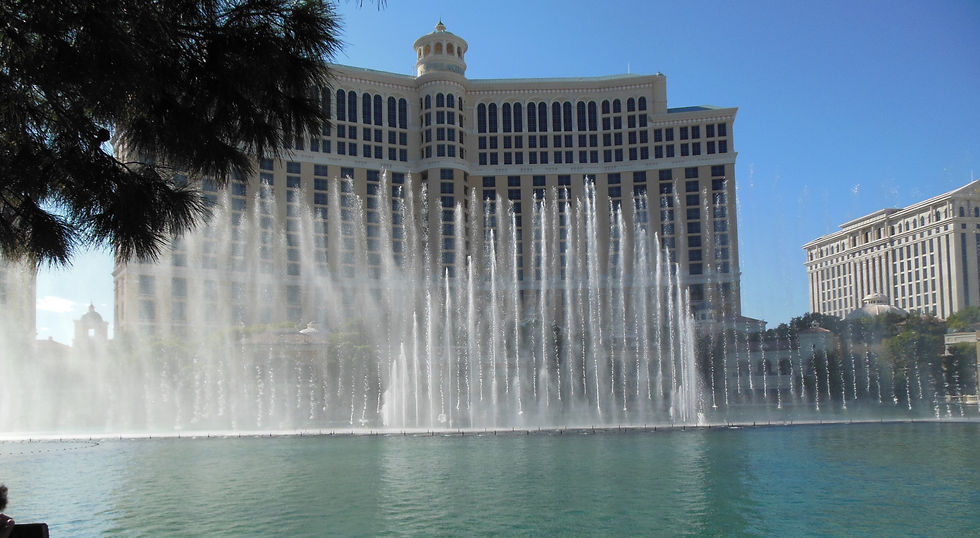
In writing this, I’m having even more difficulty than usual in working out who the audience is. Mary and I are embarking on a trip to the United States: partly A&O related; partly to spend a long weekend with friends; and partly to see some parts of the US that neither of us have been to before – Las Vegas and the Grand Canyon (the latter part organized by the great firm of Original Travel, in the shape of their American expert, Olga Pavlova).
I need to explain. The A&O part arises because the International Bar Association, the IBA, is holding its annual conference (which I used to participate in, but don’t now) in Boston; and A&O always gives a lavish party during the conference week, followed by a convivial dinner for the A&O insiders. I still like to go to at least some of the social events to see old friends (and so does Mary). The long weekend follows from all this: one of the old friends is Bill Rowley, a Canadian lawyer, and his wife Janet, who we see quite a lot of and with whom we’ve developed the habit of joining after the conference – this time it’s in Vermont, a few hours drive from Boston. But some time ago, it seemed to me a bit rich to cross the Atlantic for a party and a weekend (even a long one). So I talked to Original Travel (my daughter, Julie, works for them) about seeing the great scenic marvels in and around the Grand Canyon. And so it all got organized.
Back to my original problem: who am I writing this for? Partly Original Travel, as Julie is keen to see client journals and blogs so that she can extract bons mots (if any) for their promotional material. However, I have to ignore that, as anything that sounds as though it’s written for the purposes of promotion is useless for that – it’s got to be genuine, warts and all. The other reason for writing is personal: so that I can remember it all, without all the memories fading into each other.
Boston – 9 October
We arrive in Boston, wondering if the US federal government shutdown will affect us. As we set off, all the national parks, including the Grand Canyon, are closed. (The whole concept of closing the Grand Canyon sounds a little surreal, but that’s the fact.) Everyone is waiting for the Republican-controlled House of Representatives to approve Obama’s budget and vote him the money to keep the show (including our trip) on the road. The very, even unusually, friendly girl at the immigration desk is pessimistic. We are reassured that Olga is monitoring the situation . . .
Boston is at its best, under bright clear skies – and the parties great. The only surprise to me was being constantly accosted by beggars in the street – not something I remember from previous visits.
Vermont – 11-14 October
After Boston, we meet up with our Canadian friends and spend two or three days at the delightful Woodstock Inn in Woodstock, Vermont (not to be confused with the other one in New York). Bill and I each painted some pictures, trying somewhat unsuccessfully to capture the vibrant autumn colours: a small disappointment as a rainstorm the weekend before had taken its toll. While we were there (obviously as a result of Olga’s influence), the politicians in Washington sorted out their differences at least enough to allow the national parks to reopen. A lucky piece of timing.
Las Vegas – 15-16 October

We’re now in Las Vegas. Here am I, sitting in our room in the Bellagio hotel, situated right on the “Strip”, watching the amazing dancing fountains at the front of the hotel, against a backdrop of the Eiffel Tower straddling the Opera Garnier and (I guess) the Crillon hotel with the Arc de Triomphe in the background. Actually the real background is a 30-storey hotel that looks a bit like an expanded version of the Pierre in New York. The big question is: Is this the ultimate in vulgarity? Or is it actually fun and even beautiful? All of the above, so far as I’m concerned.
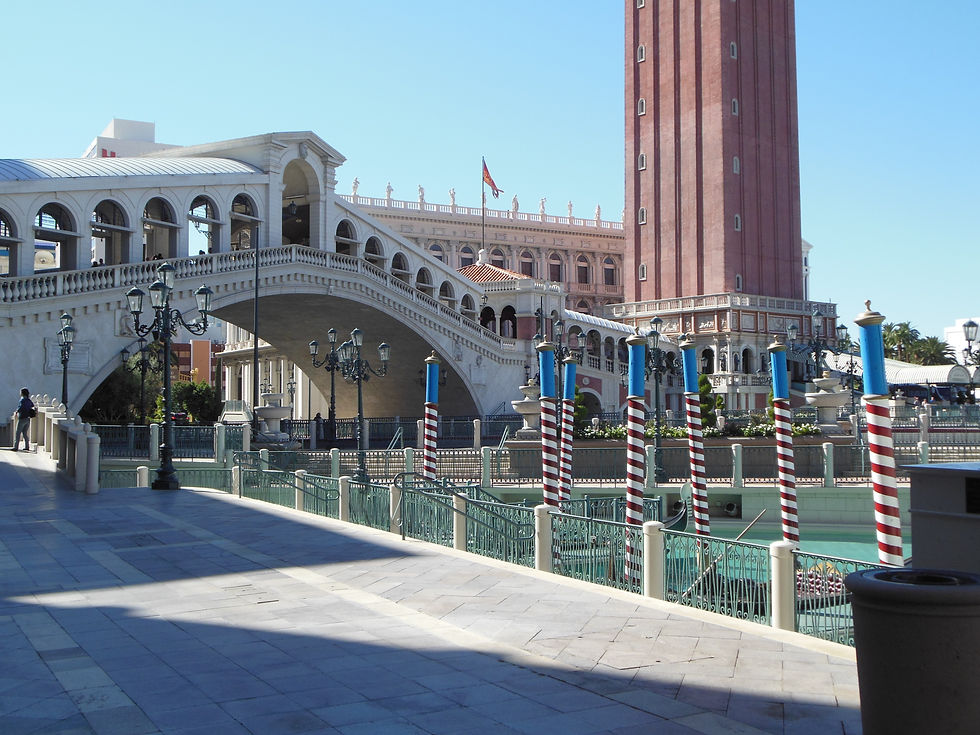
The Venetian – another hotel - is the best example. The entrance is the Doge’s Palace, with the Rialto Bridge and the Bridge of Sighs next to it and a vast version of the Campanile in front (only some of which you can see on the left). Then there are the canals, of course, with gondola rides and singing gondoliers. But inside, up the escalator, under various ceiling murals copying Veronese and others (including non-Venetian Michelangelo), there is the Grand Canal winding its way past the most expensive and elegant shops (such as Gucci, Prada, Tiffany, etc) – all seemingly empty. One suspects that the average tourist in Vegas is not part of the regular clientele of these splendid establishments. Why are they here? Subtle marketing, I guess.
What is not in doubt is that the business of Las Vegas is gambling. This is not a big surprise. What is a surprise is the extent of it. The lobbies of all the hotels are essentially casinos: our hotel lobby is a vast hall of many hundreds of slot machines, crap tables, roulette wheels, baccarat games, you name it; all operating round the clock, frankly somewhat deserted during the morning, but heaving during the rest of the day and into the night. The sight of the weary croupiers as you go to an early breakfast is not a pretty one.
The other big thing in Vegas is the shows. So far, as I write, we have only seen one: the Rêve, the dream. This was at the Wynn, a newer palatial hotel, created by Steve Wynn, an important figure in the development of Las Vegas. The theatre, in the hotel, is an amazing, lavish theatre-in-the-round, the central stage being water or, as you go in, mist gently rising from it. My neighbours are two Chinese ladies, mother and daughter, living in Sydney and Hong Kong respectively – typical Vegas visitors.
(I’m now distracted from my writing by seeing out of the window the 6.00pm fountain display, with full lighting effects now that it’s getting dark.)
But back to the Rêve. It’s quite magnificent. Starting quietly with a young girl in a bright red dress coming onto the dry parts of the central stage with her boyfriend and lying down. You hope she won’t get wet and spoil her hair-do. She then, alarmingly, sinks slowly into the water and fails to reappear (until later). And the dancing starts – the dream. A vastly impressive mixture of aquatic acrobatics, music, diving, swimming, dancing, including the most frightening exhibitions of daring stunts. Very enjoyable – and no fatalities. My only slight quarrel with it is that I soon lost interest in what it’s all meant to be about. A dream? Well, yes, but about what? Semi-nude acrobats diving and jumping into water from great heights – to exciting music. Maybe others have dreams like this more than I do. This isn’t just a quibble. It contrasts with what we saw the next night.
Next evening was a Cirque du Soleil show called “O” – as in “eau” – and therefore more water. Not having realized that the Rêve was massively aquatic when we booked, I thought we might have made a big mistake. But no, it was very different, even though there were plenty of aquatic acrobatics. The difference was that it was more varied, more artistic in the sense of more visually stunning, and with touches of humour. With the Rêve, I felt that after 90 minutes, I’d had enough, great though it all was. With O, I could have had more.
On the second day, we went to explore another extravagant hotel – the Mirage, which plays host to another Cirque du Soleil show, based on Beatles music. And so, vast images of each Beatle appear high up on the front of the hotel. Inside, there are the same rows and rows of slot machines (there must be several hundred in each big hotel). But then – the “Secret Garden”. We paid our money and went into a small zoo: a splendid display of dolphins, although we were told that they were not performing, they were being trained – a subtle distinction. And beyond the dolphins, there were some cages containing (in what appeared to be reasonably jungle conditions) white striped tigers and lions. Magnificent.
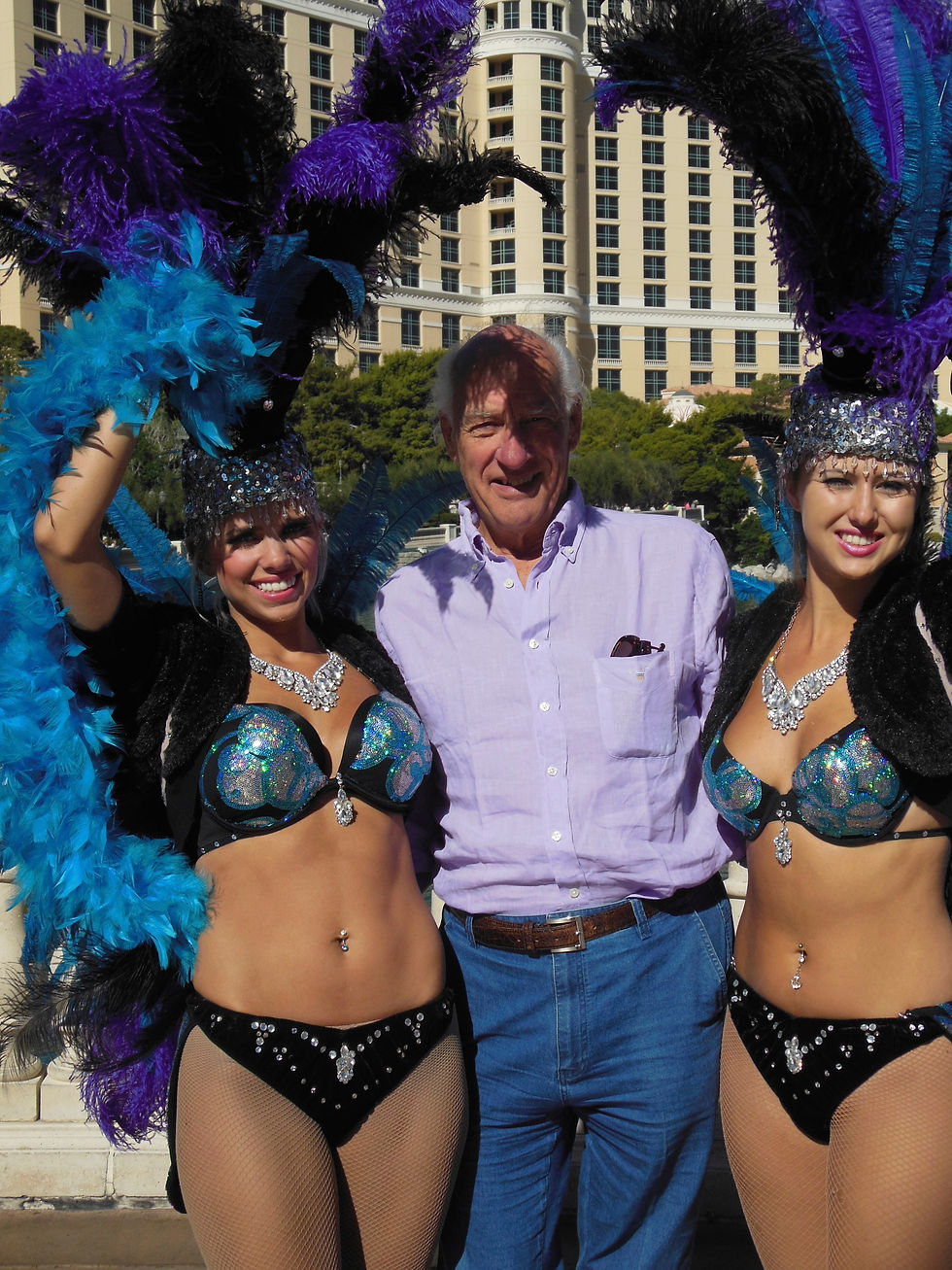
In Las Vegas, you soon get used to various aspects of the hedonistic spirit: dinner looking out over the dancing fountains; excellent food, even if in massive, overwhelming portions; the showgirls posing for photographs, with or without the photographer; the endlessly cloudless skies; and, in the hotel elevator (I’m becoming American), getting used to pressing the button marked “C” and “Casino” for the ground floor. I have to report that, as we passed through the lobby/casinos, we kept our wallets and purses firmly shut and (frankly with no difficulty at all) resisted the temptations of the slot machines – thus depriving the hotel of what is apparently its only way of making a profit. I hope the hotel manages to survive the likes of us.
The Grand Canyon – 17 October
Now for the drive from Las Vegas to the Grand Canyon – about 4-5 hours’ driving. We rent our gleaming white, almost new Nissan SUV from Avis, just outside the Bellagio. Very easy to drive. We’ve said no to a Satnav for $100, hoping to be able to rely on good old-fashioned maps and directions given, as necessary, by friendly natives. Which directions, as given by the girl on the Avis desk, work fine out of the urban sprawl of Vegas, and then through the desolate mountainous landscape towards the Hoover Dam, which we cross without, sadly, being able to see it. The landscape makes the moon look hospitable. But then it changes to flat, scrubby desert. We pass a splendid pair of road signs in a tiny village: “Veterans Home” pointing to the left; “Veterans Cemetery” pointing to the right. No mucking about.
We stop for lunch at an exit off the interstate highway, signed encouragingly “Food”. The signs in the States can be tricky to the foreigner, until you get used to them. (Hence the advisability of a Sat Nav, you may say.) Basically, it’s done mainly (and often, exclusively) by road number, distinguishing between local and interstate, and not by where the roads go, as is more typical in England and France.
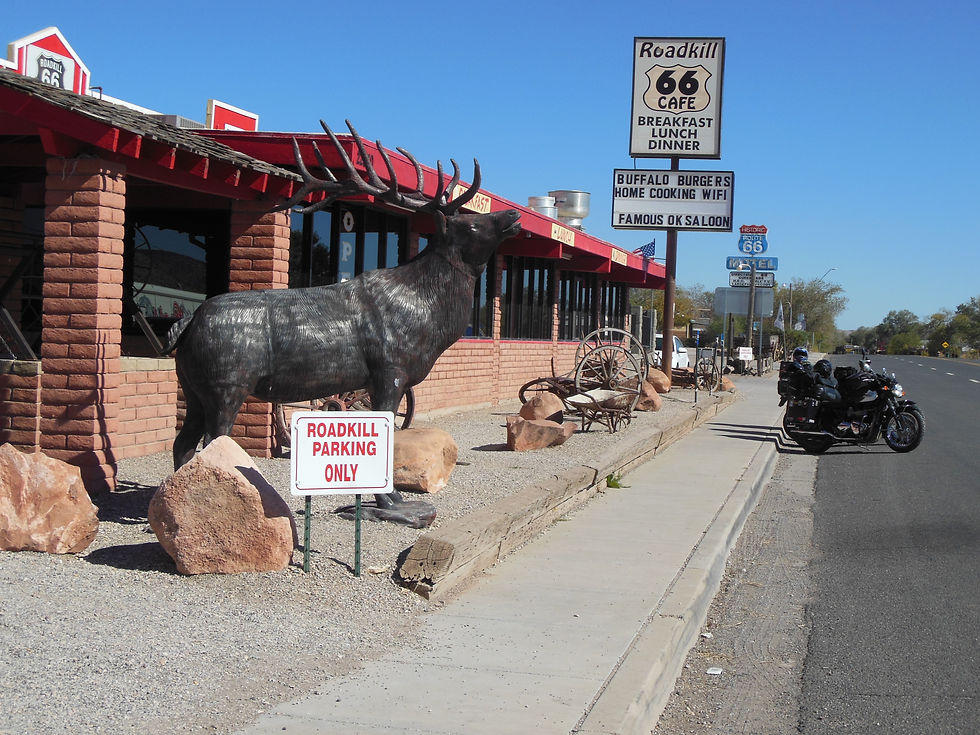
We were lucky in our choice of exit, which was entirely random. Having been slightly put off by the “Food” sign that also talked about “roadkill”, we found ourselves on the famous, even historic, Route 66. This (as everyone probably knows) was the first proper road from Chicago to Los Angeles, representing the path to freedom and riches for the beleaguered northerners in the 1920s. It still survives, although probably only in parts, having been overtaken by the modern interstate freeways. Our bit of Route 66 was full of historic memorabilia, such as a shed marked “Jail” (with a sign saying that it really was one) and the Road-Kill Café, with its menu of jokey items and a notice (plus T-shirts) saying “You kill it - We grill it”.
We arrived at the Grand Canyon by mid-afternoon and clocked into the Yavapai Lodge, a rambling collection of buildings, our room being on the first floor of one of the separate lodges. All fairly basic and impersonal; frankly slightly lacking in charm, but perfectly adequate.
We took ourselves off that afternoon to see the Canyon at sunset. The Lodge is quite near one of the key viewing points. The first view you get – probably wherever from – must always be the best, as words can’t really do justice to the sheer overwhelming magnificence, largely because of the scale of it all: ten miles across and one mile down to bottom of the valley, with the most amazing rock formations in and around the middle. Fantastic. So much so that you soon get too used to it and realize that you’re beginning to take it for granted. All the more important to allow that first impression to seep in.
Dinner is a minor challenge. The Yavapai is very basic. The best restaurant is in the El Tovar hotel, where Olga tried to get us in, but which was fully booked back in the summer. The restaurant (the only one that takes reservations) was fully booked for that evening. So we went along to the second choice in another hotel, the Amazon Room – 60-90 minute wait. No thanks. In the same hotel (they’re all near each other), we joined the shorter queue (15 minutes predicted) for the Bright Angel, which was not too bad, even if not exactly fine dining. Skipping a day briefly, we booked successfully for the El Tovar for the next evening. It was indeed much better. And the El Tovar hotel looks as though it deserves its reputation.
At the El Tovar, we made a useful discovery, getting to the bottom of the technicalities of the Dry Martini. As served everywhere we went, “Dry” means that you only get the gin (or vodka) with no vermouth at all. According to William Boyd’s new James Bond book, 007 wouldn’t have gone along with this. How this version gets away with calling itself a martini is a mystery. If you want what I – and incidentally, James Bond – think of as a Dry Martini, even a very dry one, you have to ask for a “dash” of Martini in it. The bar at the El Tovar managed this to perfection.
Grand Canyon continued – 18 October
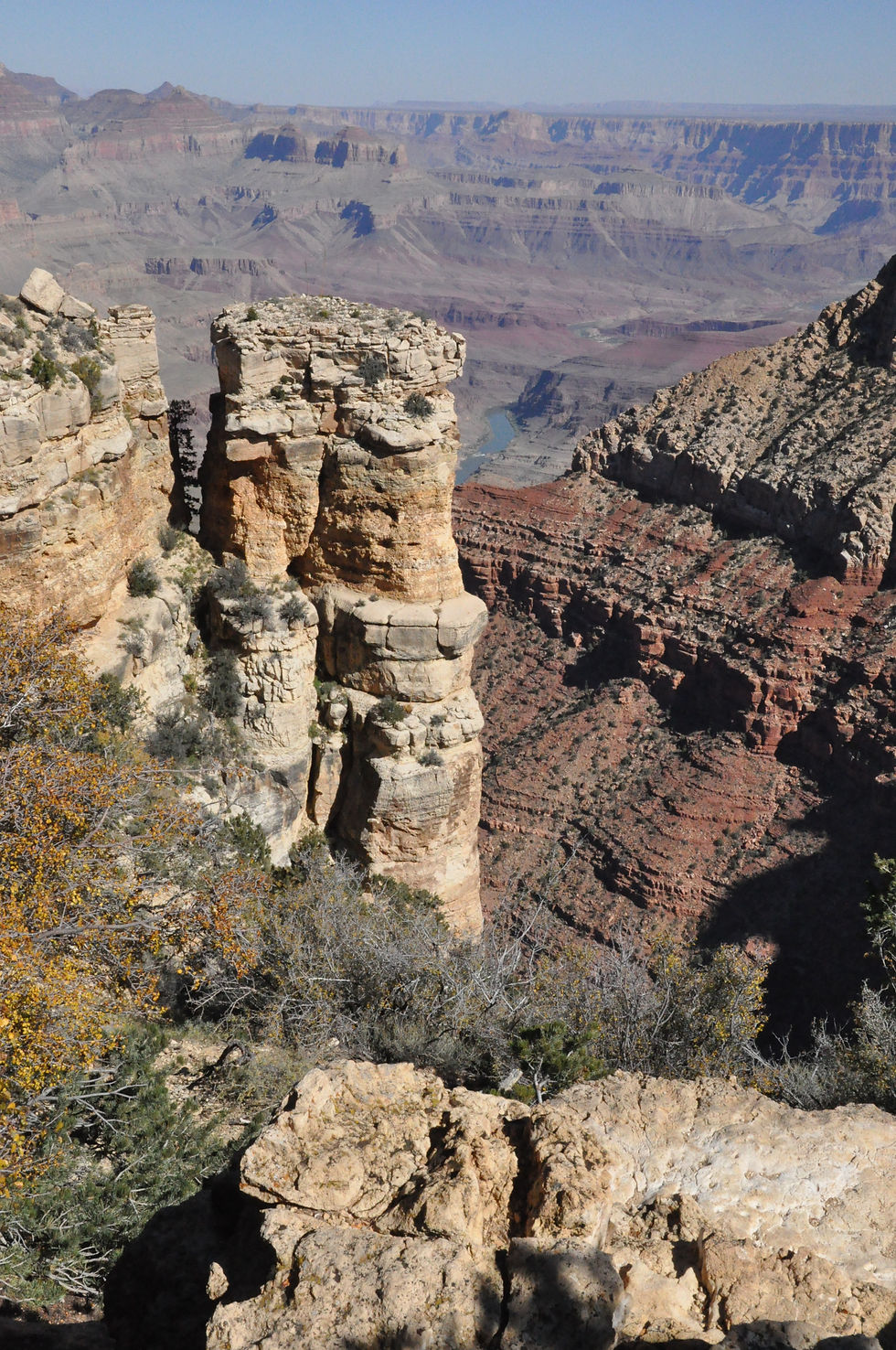
This is our full day at the Grand Canyon. I thought we should get up early (Mary not so sure), although frankly not early enough to see the sunrise. We compromised at 7.30, to go to the farthest east point in the national park, Desert View, getting there shortly after 8.00 – without having had any breakfast (me thinking – correctly I later discovered – that breakfast at the Yavapai wouldn’t be a gastronomic experience), only to discover that the Desert View didn’t open till 9.00. Frankly, how ridiculous, if sunrise is as wonderful as billed.
Still, the Desert View does offer spectacular views, partly as it is (I think) the highest point on the south rim at 7,500 feet. There is also a slightly curious tower, constructed by an architect called Mary Jane Colter, using local stone and incorporating Native Indian designs, but built around a decidedly non-Native Indian steel frame. It apparently ranks as a historic monument.
Having then had our much-awaited breakfast, we drove westward taking in many “overlooks” (we did all the top five, as listed by the Lonely Planet) and taking many, many photographs, all of which have, I’m afraid, been taken by millions of others.
I should have mentioned a reward we got for getting up early. As I went down from the room in our cabin, I was met by two large female elk, grazing happily around the lodges. And then we were also rewarded by seeing an even larger bull elk with magnificent antlers manœuvering itself with some difficulty through the woods. One should keep an eye out for wildlife. Actually, elk and deer are plentiful and easy to see. The difficult ones are the mountain lion, moose, and the California Condor (with its nine foot wingspan), none of which did we see, needless to say.
In the afternoon, we took the shuttle bus, as you have to, to the western and of the Park, still south rim. Most people go to the south rim presumably because the view of the Canyon is better with the sun behind you. Incidentally, walking is quite strenuous (you can walk between bus stops), because of the altitude.
The temperature was a surprise to me. It’s cold at night – and even out of the sun during the day – although the sun is hot. I had brought light shirts and trousers for the desert conditions – not needed!
Monument Valley – 19 October
The drive to Monument Valley, through pretty desolate scenery. We had a plan of getting a bottle of gin on the way, as Monument Valley, situated as it is in Navajo tribal territory, is dry. But we didn’t get to any signs of civilization until Kayenta, which was too late – it’s already on Navajo land. We stopped for a cup of coffee, directed to a particular café by the Lonely Planet guide, which turned out to be very closed down. Reduced to Burger King, we had what amounted to lunch in the shape of chicken strips and fries (no longer French fries) and watched Hilary Clinton on the TV drumming up support for a local governor.
On to Monument Valley. After Kayenta, you soon get to the open valley punctuated by these vast monument structures in red sandstone, famous to everyone as the backdrop to endless John Ford westerns. The hotel, the View Hotel, certainly lives up to its name: every room has a balcony looking out at five or six of the sandstone buttes or mittens. It’s hard to think of any hotel, anywhere in the world, with a better view from its rooms.
A word of explanation about the buttes and mittens: if one has what looks like a thumb pointing upwards, it is a “mitten”, because it looks like one; if it doesn’t, it’s a “butte” , pronounced “bioot” rather than the alternative, which would, I guess, sound rude to an American.
Two of the buttes (or possibly mittens) are named respectively after two intrepid but foolhardy Americans (Mitchell and Meyrick) who ventured into Indian territory in the 19th century and found silver. They were caught by the local Navajo Indians, reprimanded, and generously allowed to keep the silver – but were told not to come back. However, greed got the better of them. They did come back. They were caught again and this time executed. Always follow instructions given by Native Indian guides.
Monument Valley continued – 20 October
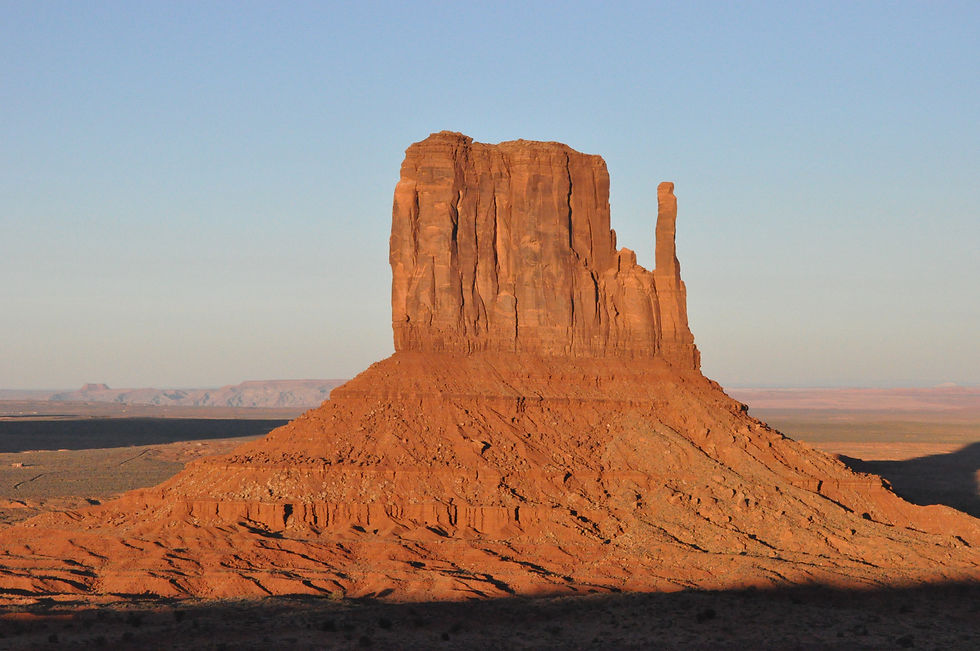
I am writing this on the balcony of the View Hotel, having seen the sun come up at 7.35 in the morning. Last night we saw it go down and watched patiently for the almost full moon to come up at the same time. Unfortunately it rises behind a butte, so you can only see it when it reaches the top of the butte by which time it’s dark. The night before, one of our fellow guests had photographed the then full moon appearing to balance on top of the butte just as it was getting dark.
We’ve booked a guided tour, for four but it turns out to be just us, in a jeep with the redoubtable and splendidly named Will Cowboy. His name isn’t his only distinction. He comes from a Native Indian family that has lived in Mystery Valley (just to the north of Monument Valley) for some years. His grandparents seem to have been key figures in the local history. He himself spent some time as a welder in San Diego, but his mother tongue is Navajo. Sadly, the number of children learning the language is in steep decline. (I got this latter point from the information in the hotel, not from him. I don’t know whether his children speak Navajo.)
We heard a lot about Navajo traditions and legends and a bit about the somewhat shameful history when in the 19th century they were rounded up, imprisoned in New Mexico, and then released to walk back to their Navajo homeland. Needless to say, Will is an expert guide around the monuments, having ridden everywhere since he was 6 years old. He has five children, the youngest being already able to ride at 4 years old.
The tour is a lot about the naturally sculptured images made by the monuments: the elephant butte; the camel butte; the three sisters at the end of the Mitchell mesa (also named after the unlucky silver explorer) – a “mesa” being a kind of table mountain. The names tend to be a mixture of English, Spanish and Navajo words. We saw much beautiful but tough little gorse-like plants, making a delicate green background to the monuments; including the Yacca which has roots the Navajo used for what Will described as shampoo. Interestingly, they also make an alcoholic drink from the dwarf cedar trees (maybe less now than in the past, as it’s illegal). He showed us the typical Navajo dwellings, known as “hogons”: those with a pointed roof for men and those with round ones for women. He also sang Navajo songs in one of the arched caves, accompanied by his hand-held drum made of buckskin.
Incidentally, I should probably be doing a bit of editing in the interests of political correctness, but perhaps I won’t. I refer to Native Indians, refraining from saying Red Indians, even though that is what I grew up calling them. I still remember a delightful little book I had as a child, the “Red Indian Twins” about a charming and blameless family living in their wigwams. (I also had another, the “Eskimo Twins” which has now, I imagine, had to be redacted or pulped.) I still find it difficult to say Native American, even though they are of course American citizens (although only since 1924) and have the vote (although, again perhaps surprisingly, only since 1948-53). After all, George W Bush and Bill Clinton are also native Americans. I think in Monument Valley, I’ll try to stick to “Navajo”, although Will tells us that this is the name the Spanish conquistadors gave them, and that its original meaning had something unpleasant to do with scalping their enemies. He told us what they call themselves, which is simply the Navajo for “people”. It sounded quite unpronounceable but the museum tells us it’s “Diné” - which is easy enough.
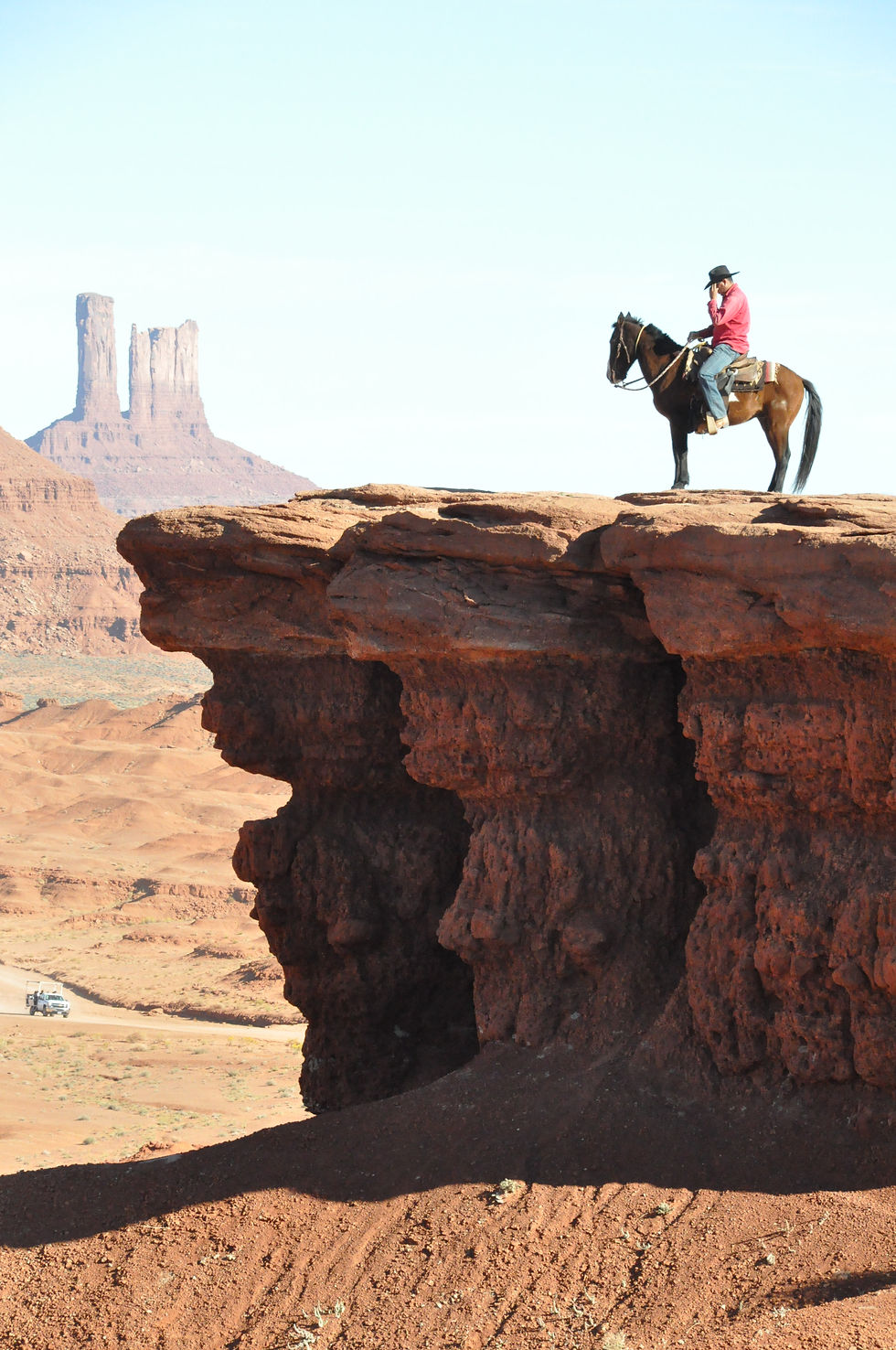
There was a major photo opportunity when we came to a horse and a rocky ledge. For the princely sum of $2 the horse’s minder, dressed as a cowboy, jumps on it and rides vigorously to the ledge – just as in The Lone Ranger and countless Marlboro’ cigarette ads. Hollywood fell in love with Monument Valley after John Ford chose it as the setting for the early John Wayne movie, Stagecoach. The whole place is full of Hollywood memorabilia. We stand on the balcony of the View Hotel, admiring the great monuments in front of us from what the sign says was John Wayne’s favourite spot.
Incidentally, the food at the View is not one of its strengths. The safest choice is one of the relatively tasteless stews, allegedly in Navajo style. Otherwise it’s vast helpings of the dreaded battered chicken and such like.
The Arches – 21 October
This is to be a full day: driving to Moab (predicted time 3 hours); checking in to the Red Cliffs Lodge; getting some lunch; and seeing another national park, The Arches.
We left early, hoping to get to Red Cliffs Lodge by around midday. But before leaving, we wanted to resolve a concern that probably occurs with many foreigners in the States – the dread subject of tipping. Without much thought, I had pressed $20 into the hand of our splendid guide Will, who took it with a blank expression that could have indicated disappointment – or perhaps amazement that we had thought to give him anything (not likely!). On reflection, we thought we’d been mean. Actually we wanted to be generous. The price of the tour was $190 for three hours – not particularly cheap. But how much would he get of that? Who knows? So, $20 is a measly 10%. We all know that tips in the States are now north of 15%. So we decided to give him another $20. We found him as we left. He seemed grateful and amazed – still in a somewhat inscrutable way. But we felt that we hadn’t unduly fuelled the reputation of the Brits for institutional meanness. However, I’m not keen on the system. I prefer the Japanese approach – no tips.
We drove through the delightfully named town, Mexican Hat. Why is it called that? The question was soon answered when we saw the famous rock that looks like a Mexican, or whoever, wearing what is undoubtedly a Mexican sombrero.
Moab is obviously the centre for all sorts of leisure activities. Our hotel is the Red Cliffs Lodge, not in Moab but 14 miles away along the Colorado River. The drive, although unexpected, is one of the most spectacular you can imagine, with rich red terracotta sandstone cliffs rising high on either side and the Colorado River running by the winding road.
The hotel is a rustic lodge with a multitude of individual cabins, all by the river and under massive rock cliffs. Very comfortable.
To go to the Arches National Park, you have to go back along the 14 mile road. We’re going to get to know it quite well, but not a problem. Then into the Park.

The first thing to say about Arches is that it’s not all about arches. All the publicity, including Original Travel’s itinerary, understandably has a picture of one of the dramatic arches. However, the one most featured is actually quite difficult to get to, as are some of the others. What the Park also has are the most amazing formations of red sandstone rocks (which we’ve been given a taste of during the 14 mile drive), actually in many ways even more exciting than the famous ones in Monument Valley. The rocks have been eroded over millions of years into the most extraordinary – and beautiful – shapes. It takes very little imagination (somewhat in contrast to Monument Valley) to see human shapes and faces and groups. The first one you see is the gossiping ladies – very accurate (see above). Then the famous balancing rock, which looks as though it might topple off its perch sometime well before the next ice age – like tomorrow.
Getting back to the Lodge, I’m faced with a picture on the wall with yet another magnificent arch, which we certainly didn’t see. It’s probably the one towards the end that involved a mile or two of hiking that we didn’t feel up to. Maybe Arches is one of the places where we could have spent longer. Also, we didn’t really have time to see the “Island in the Sky” (whatever that is) in Canyonlands National Park, which is not far away.
Red Cliffs Lodge is very special indeed: attractive rustic rooms; delightful staff; excellent food (a nice change after the Navajo regime); and last, but not quite least, a refreshing Dry Martini, followed by wine produced at the ranch.
Towards Bryce Canyon – 22 October
In the morning we open the door to the sound of rushing water, the rapids of the Colorado River, with the red cliffs dramatically above. Sad to leave.
On to Bryce Canyon. There are two routes: one taking the Interstate Freeway 70 (ie a motorway) as far as possible and taking smaller roads only towards the end; the other taking the Freeway to start with, but turning off as soon as possible to take smaller roads (routes 24 then 12) on a more direct route. The first is quicker, but the second more scenic, according to the lady at the bar of the Red Cliffs Lodge, who makes a good Dry Martini and seems also to be a good travel adviser. We take her advice. Original Travel’s itinerary says the whole journey takes 4 ½ hours. We took about 6 hours, not counting stops, so presumably Original Travel went for speed (as probably would a Satnav, had we had one). I’ll record our route in a bit of detail partly for OT, as it was full of discoveries and delights.
The first part of the route is unpromising. The Freeway is perfection, maybe recently built. But it goes through desolate country, as initially does the smaller road that we then took. It all changed after a town called Hanksville. The scenery changes dramatically. One surprise is trees – cottonwood trees we were told – growing in the valley of the Fremont River. As already mentioned, we had missed the real extravagance of autumn colours in Vermont. Down south we’re more lucky. The cottonwood trees have a bright golden glow that shows up splendidly against the russet red of the cliffs.
Another surprise was the variety of the colours in some of the cliffs. Often you get the deep terracotta red at the top, then a layer of almost white rock and under that a weird cherry jam colour, making it look as though jam as been spilt over ice-cream. (This may sound a touch fanciful, but it isn’t.) And then there are valleys of dark, almost black, rock – less attractive, rather gloomy.
We passed through a mini-town called Torrey. It is just by yet another canyon – the Torrey Canyon. I guess, as Michael Caine might say, not many people know that the supertanker that came to grief all those years ago was named after a canyon in remote Utah.
On to our lunch stop. We have to drive over a substantial mountain, Boulder Mountain. This is another complete surprise, as US road maps don’t do contours (nor do ours, I suppose). We climbed, on an immaculate though winding road up to over 11,000 feet – higher than most Alpine ski resorts – with pine forests and magnificent panoramic views. At last, when over the mountain, we reach Boulder (not to be confused with the better known one in Colorado).
The Lonely Planet speaks highly of the Hell’s Backbone Grill. Rightly so. A real discovery. It’s a beautiful cabin-style wooden building. The restaurant is run by a couple who are a mixture of Mormon and Buddhist. I’m not exactly sure how this works, but the result is an enormously friendly welcoming place, serving food that has been rated by all sorts of magazines and by Zagat. We bought the T-shirt and, I’m afraid, the cap to remember it by – even if we won’t probably be wearing them much.
Then on for the 70-odd miles to Bryce, starting on a mildly terrifying road that runs along a rocky spine with big drops on either side. It’s called either the Hogsback Ridge or the Devil’s Backbone – both names seem to fit the bill.
Bryce Canyon – 23 October
The Bryce Canyon Lodge is the only hotel actually in the Park itself; and also the only survivor of the various lodges built by Gilbert Stanley Underwood in the 1920s, although some of the others, having burnt down, have been rebuilt. It still has its rustic charm with the all-pervading smell of the log fire burning away in the lobby.

There is also an old-fashioned, no-nonsense service, including a distinctive no-reservation system for dinner. This is controlled, in a politely authoritative way, by a small bald man with thin-rimmed spectacles and a neat moustache, who explains that he’ll put you on the waiting list, gives you a pager and tells you firmly that there will probably be a 30 minute wait. Fortunately, his estimates are pessimistic. What you can’t do is wait in the bar: tradition (in this case Mormon tradition) is observed by the lack of a bar. Drinks are only served with food; and then it’s wine or beer – no naughty spirits. The service is impeccable, again old-style but very friendly, delivered by waitresses of ample proportions who have been at the hotel for ever (in the case of one, for over 40 years, since she was 10 years old – hopefully not full-time then). The food is excellent, also in ample portions. Our lovely waitress presents the bill and says, “I’ll be your cashier when you’re ready.”
One point I find interesting is that many places now ask if you’d like them to add the 18% service in the bill (yes, 18% these days). I assume that too many foreigners either don’t realize that they should tip or, probably mostly if British, tip too low.
On to the Park itself. We have a whole day to see it, so can take it at a leisurely pace. Bryce Canyon is not a canyon at all: it is the edge of a vast plateau, created many millions of years ago when this part of the world was being pushed upwards, forming among other things the Rocky Mountains. The plateau’s edge has been eroding over a smaller number of millions of years to form the bizarre structures that Bryce is famous for. A ranger who gave a fascinating talk about it said that it should really be called the Bryce Eroding Plateau National Park, but admitted that this would lack a certain oomph and pizzazz.
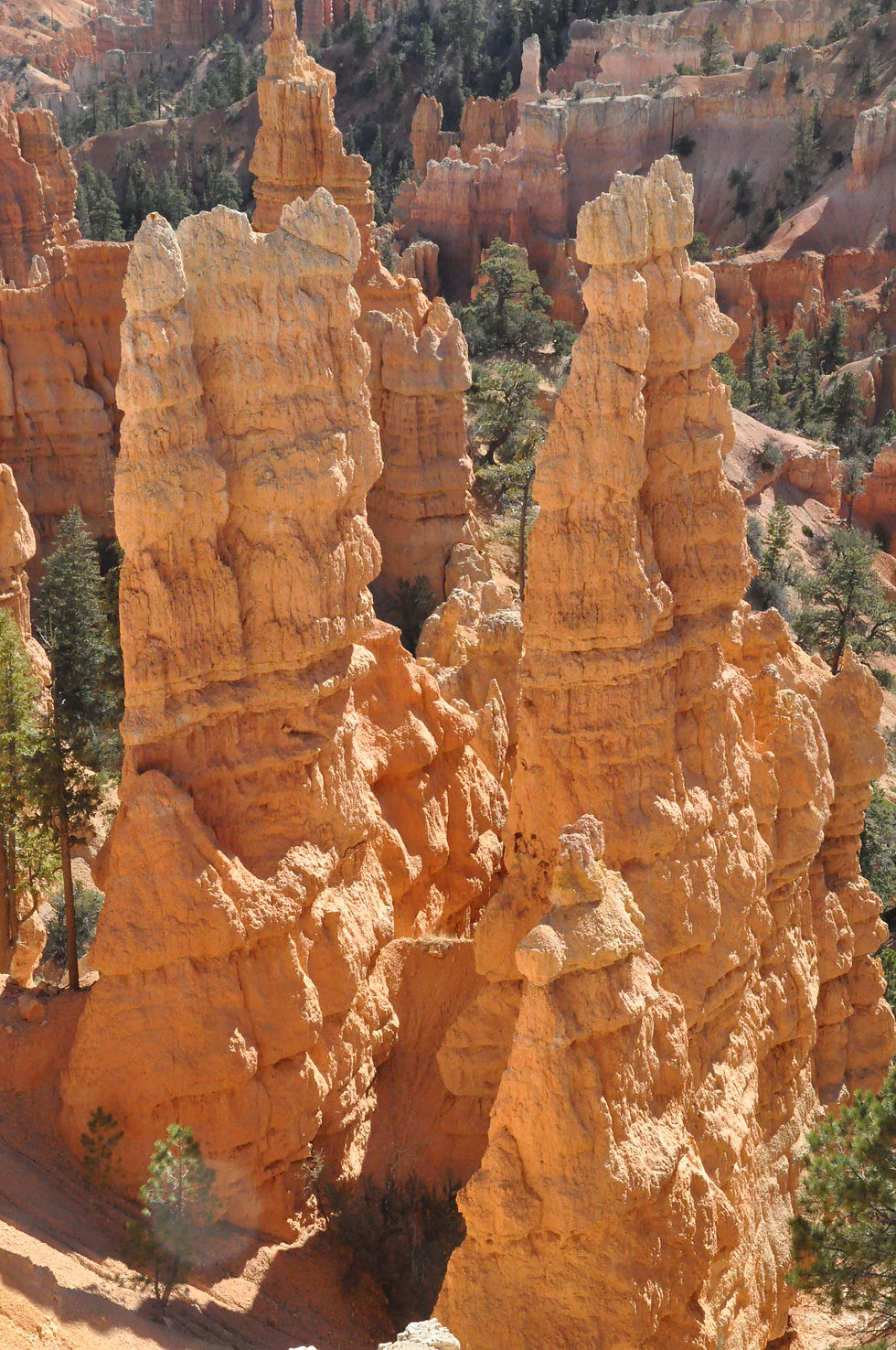
The result is that you drive along the edge of the plateau for about 20 miles, on a well-maintained road with lots of “overviews” and “take-outs” (the latter being American for lay-by), where you stop and admire the view. The views are, of course, of the famous structures, known as “hoodoos”, probably from a Native Indian word for bogeyman. The hoodoos and cliffs are more fascinating, impressive and unusual than anything you can imagine, even with the help of photos; partly – as with the Grand Canyon – because of the sheer size of it all.
One surprise (you’ve heard this before and it’s again because of a lack of homework) is the temperature. Bryce is the coldest place we’ve been to. It shouldn’t be surprising, as the Lodge stands at about 7,000 feet and the rim of the (non)canyon goes up to over 9,000 feet. The overnight temperature was below freezing. It warms up during the day, in the sun, but gets seriously cool after about 4.30. There is a neat little pile of snow outside our bedroom window, which shows no obvious sign of melting.
The service at the Lodge really is impeccable. We befriend two waitresses in particular (neither of whom conform to my impolite description above). One, Leslie, warmly embraced Mary when we were leaving. The other, Jill, stood out by remembering in detail on day two my breakfast order from the day before, despite – or perhaps because of – its being apparently so unusual: granola and blueberries (what’s so unusual about that, you may ask?). I congratulated her – “memory girl”. Well, she said, I would be “blueberry man” to her.
Zion – 24 October
The drive to Zion is only 1 ½ hours to the beginning of the Park, although (as described below) it takes a bit of time negotiating your way up to the Lodge.
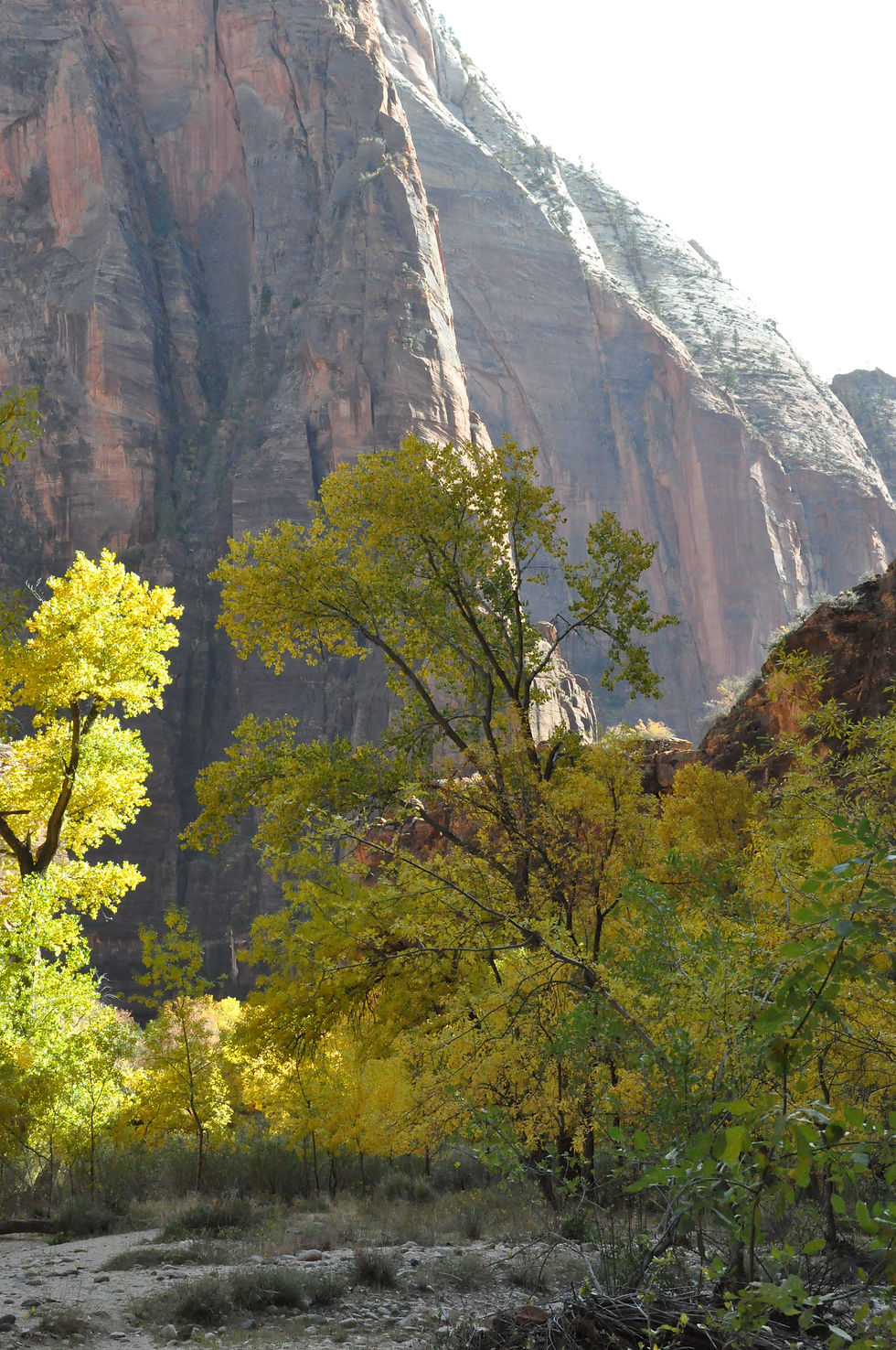
Zion is a real canyon, carved out of the red sandstone by the Virgin River. After all the magnificence and variety of the Grand Canyon, Monument Valley, Arches, Bryce, it’s easy to ask what can Zion possibly add? Well, it’s different again. The first thing is that you’re in a valley, so you’re looking up all the time and also it’s a lot warmer – at under 5,000 feet. The second thing is that the cliffs and rocks that tower above you are like vast walls, eroded not into bizarre shapes but into mountains of smooth red rock. The drive into the Park, before you get to the visitor centre, is probably the most impressive part. But the so-called scenic drive carries on up the canyon until it narrows right down, allowing only hikers to continue. Actually, Zion is probably mainly a centre for hikers.
The entry to the Park – or rather to the scenic drive up the canyon – is slightly alarming; a large notice says that you can’t drive there without a “red permit”. The Zion Lodge, where we happen to be staying, is way up the scenic drive. You go to the visitor centre, not knowing whether or not you have to unload everything onto a shuttle bus: some parts are only accessible by bus. But, happily, the girl at the visitor centre issues us with the coveted red permit when shown our booking at the Lodge. Incidentally, the visitor centre has the best shop anywhere for mementos of the various parks.
On the way into the Zion Park, we saw some dozen dead deer, some beside the road, some in the fields. Why ever? We asked the girl at the gate to the Park. She explained, a little nonchalantly, that it was now the hunting season; some would have been shot by hunters (but why left in the fields?); others (presumably all those by the road) might have been frightened by the hunters and the shots and got killed running on to the road.
Back to reality – 25 October
Now sitting on the JetBlue plane at Las Vegas bound for New York and home. Time to reflect.
First, it’s an almost unreal experience. As the girl at the desk of the Zion Lodge said, in philosophical mood, Nature was good in putting all these marvels so close together, or words to that effect. She’s right. Any one of the places we went would be regarded as one of the wonders of the world. And yet they’re all quite different from each other.
A lot of the people we came across were of course doing much the same tour of much the same places. But most seemed to be doing it in the reverse direction, presumably to end up at the Grand Canyon. Maybe the plan was to leave the best till last. To start with, I thought they might be right. Won’t the other places seem a series of anti-climaxes? But actually they don’t. Each is amazing in its own way. So I think Olga got it just right.
There’s no doubt that coming back to Nevada with its garish roadside posters and lurid resort motels, and then to Las Vegas, even speeding past it on the Freeway to the airport, brings you back with a jolt, from the calm and silence of the Zion Lodge.
Tony Herbert
October 2013

Comments